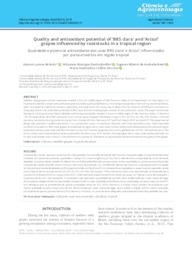Quality and antioxidant potential of BRS clara and Arizul grapes influenced by rootstocks in a tropical region.
Quality and antioxidant potential of BRS clara and Arizul grapes influenced by rootstocks in a tropical region.
Autoria: BRITO, A. L. de; BONFIM, W. M. D.; ANDRADE NETO, E. R. de; LIMA, M. A. C. de
Resumo: Seedless table grapes cultivars have been studied in the Sub-middle region of São Francisco Valley at northeast Brazil. For that region, it is important to identify cultivars with productive potential, better quality and efficiency, minimizing the expenses in terms of inputs and workforce, when compared to traditional cultivars. Specifically, the objective of this study was to determine the influence of different rootstocks on the quality and on the antioxidant potential of BRS Clara and Arizul table grapes cultivars of two production cycles. The experimental area belongs to the Experimental Field of Bebedouro/Embrapa Semiárido, located in the sub-middle region of São Francisco Valley, in Petrolina - PE, northeast Brazil. Both BRS Clara and Arizul cultivars were analyzed individually using IAC 313, IAC 572, IAC 766, SO4, Paulsen 1103 and Harmony rootstocks, during production cycles from October/2016 to February/2017 and from March/2007 to June/2017. The experimental design was planned in randomized blocks, in a 2 (production cycle) x 6 (rootstock) factorial, with three replications each. More favorable conditions to quality for ?BRS Clara? grapes, as evidenced by higher berry mass, lower soluble solids (SS)/titratable acidity (TA) ratio and higher antioxidant activity, were observed after the March-June, 2017 harvest, especially from scions grafted onto IAC 572, SO4 and Harmony. The Arizul cultivar was characterized by better quality after the March-July, 2017 harvest, showing higher berry mass, lower acidity and lower SS/TA ratio and a better color mainly in SO4 and Harmony rootstocks. Therefore, an appropriate rootstock enhances the quality of the grapes.
Ano de publicação: 2019
Tipo de publicação: Artigo de periódico
Unidade: Embrapa Semiárido
Palavras-chave: Arizul, BRS Clara, Cultivar, Grapes, Porta Enxerto, Seedless varieties, Uva, Uva de mesa, Uva sem semente, Vale do São Francisco, Viticultura tropical
Observações
1 - Por padrão são exibidas publicações dos últimos 20 anos. Para encontrar publicações mais antigas, configure o filtro ano de publicação, colocando o ano a partir do qual você deseja encontrar publicações. O filtro está na coluna da esquerda na busca acima.
2 - Para ler algumas publicações da Embrapa (apenas as que estão em formato ePub), é necessário ter, no celular ou computador, um desses softwares gratuitos. Sistemas Android: Google Play Livros; IOS: iBooks; Windows e Linux: software Calibre.
Acesse outras publicações
Acesse a Base de Dados da Pesquisa Agropecuária (BDPA) para consultar o acervo completo das bibliotecas da Embrapa.

